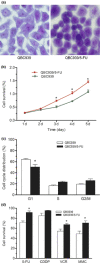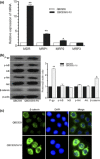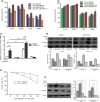Inhibition of Wnt/β-catenin signaling downregulates P-glycoprotein and reverses multi-drug resistance of cholangiocarcinoma
- PMID: 23822562
- PMCID: PMC7656555
- DOI: 10.1111/cas.12223
Inhibition of Wnt/β-catenin signaling downregulates P-glycoprotein and reverses multi-drug resistance of cholangiocarcinoma
Abstract
The development of multi-drug resistance (MDR) represents a major obstacle in the successful treatment of cancers. However, the factors and mechanisms that lead to MDR in cholangiocarcinoma (CCA), a chemoresistant bile duct carcinoma with a poor prognosis, remain unclear. In this study, we established a human MDR CCA cell line QBC939/5-FU. Compared with QBC939 cells, a rounder shape, a higher nuclear-cytoplasmic ratio, a shorter cell cycle, faster growth and resistance to chemotherapeutics are major characteristics of QBC939/5-FU cells. P-glycoprotein (P-gp) and β-catenin were upregulated in QBC939/5-FU cells. Furthermore, the drug susceptibility of QBC939 cells to common chemotherapeutics was significantly decreased after Wnt3a treatment, whereas inhibition of Wnt/β-catenin pathway by β-catenin siRNA reversed the MDR of QBC939/5-FU cells to chemotherapeutics. Molecular study revealed that activation of Wnt/β-catenin pathway resulted in upregulation of P-gp and contributed to MDR of QBC939/5-FU cells. Extraction of Siamese Crocodile 3 (ESC-3) bile enhanced the drug sensitivity of QBC939/5-FU cells to 5-FU, paralleled with downregulation of β-catenin and P-gp. The association of Wnt/β-catenin pathway and P-gp was further confirmed by the clinical data for CCA tissues. Our study represents the first implication of Wnt/β-catenin activation in the MDR of CCA, which may be a beneficial target for the clinical treatment of CCA.
© 2013 Japanese Cancer Association.
Figures




Similar articles
-
β-escin reverses multidrug resistance through inhibition of the GSK3β/β-catenin pathway in cholangiocarcinoma.World J Gastroenterol. 2015 Jan 28;21(4):1148-57. doi: 10.3748/wjg.v21.i4.1148. World J Gastroenterol. 2015. PMID: 25632187 Free PMC article.
-
Modulating Wnt/β-catenin pathway activity to enhance chemosensitivity in cholangiocarcinoma.Biomed Pharmacother. 2025 Jul;188:118225. doi: 10.1016/j.biopha.2025.118225. Epub 2025 Jun 4. Biomed Pharmacother. 2025. PMID: 40472719
-
Oncogenic activity of retinoic acid receptor γ is exhibited through activation of the Akt/NF-κB and Wnt/β-catenin pathways in cholangiocarcinoma.Mol Cell Biol. 2013 Sep;33(17):3416-25. doi: 10.1128/MCB.00384-13. Epub 2013 Jun 24. Mol Cell Biol. 2013. PMID: 23798555 Free PMC article.
-
Wnt/β-catenin signaling as an emerging potential key pharmacological target in cholangiocarcinoma.Biosci Rep. 2020 Mar 27;40(3):BSR20193353. doi: 10.1042/BSR20193353. Biosci Rep. 2020. PMID: 32140709 Free PMC article. Review.
-
Wnt-β-catenin Signaling Pathway, the Achilles' Heels of Cancer Multidrug Resistance.Curr Pharm Des. 2019;25(39):4192-4207. doi: 10.2174/1381612825666191112142943. Curr Pharm Des. 2019. PMID: 31721699 Review.
Cited by
-
BATF2 reverses multidrug resistance of human gastric cancer cells by suppressing Wnt/β-catenin signaling.In Vitro Cell Dev Biol Anim. 2019 Jun;55(6):445-452. doi: 10.1007/s11626-019-00360-5. Epub 2019 May 28. In Vitro Cell Dev Biol Anim. 2019. PMID: 31140101
-
A Review of Approaches to Potentiate the Activity of Temozolomide against Glioblastoma to Overcome Resistance.Int J Mol Sci. 2024 Mar 12;25(6):3217. doi: 10.3390/ijms25063217. Int J Mol Sci. 2024. PMID: 38542190 Free PMC article. Review.
-
Higher expression of high-mobility group box 1 in cholangiocarcinoma and association with cell growth, in vitro migration and invasion, and chemo-drug sensitivity.Sci Prog. 2025 Jul-Sep;108(3):368504251362343. doi: 10.1177/00368504251362343. Epub 2025 Jul 21. Sci Prog. 2025. PMID: 40686460 Free PMC article.
-
Quercetin potentiates 5-fluorouracil effects in human colon cancer cells through targeting the Wnt/β-catenin signalling pathway: the role of miR-27a.Contemp Oncol (Pozn). 2022;26(3):229-238. doi: 10.5114/wo.2022.120361. Epub 2022 Oct 24. Contemp Oncol (Pozn). 2022. PMID: 36381675 Free PMC article.
-
MicroRNA-452 contributes to the docetaxel resistance of breast cancer cells.Tumour Biol. 2014 Jul;35(7):6327-34. doi: 10.1007/s13277-014-1834-z. Epub 2014 Mar 20. Tumour Biol. 2014. PMID: 24648265
References
-
- Lazaridis KN, Gores GJ. Cholangiocarcinoma. Gastroenterology 2005; 128: 1655–67. - PubMed
-
- Shaib Y, El‐Serag HB. The epidemiology of cholangiocarcinoma. Semin Liver Dis 2004; 24: 115–25. - PubMed
-
- Rocchi E, Khodjakov A, Volk EL et al The product of the ABC half‐transporter gene ABCG2 (BCRP/MXR/ABCP) is expressed in the plasma membrane. Biochem Biophys Res Commun 2000; 271: 42–6. - PubMed
-
- Gillet JP, Efferth T, Remacle J. Chemotherapy‐induced resistance by ATP‐binding cassette transporter genes. Biochim Biophys Acta 2007; 1775: 237–62. - PubMed
Publication types
MeSH terms
Substances
LinkOut - more resources
Full Text Sources
Other Literature Sources
Medical
Miscellaneous

